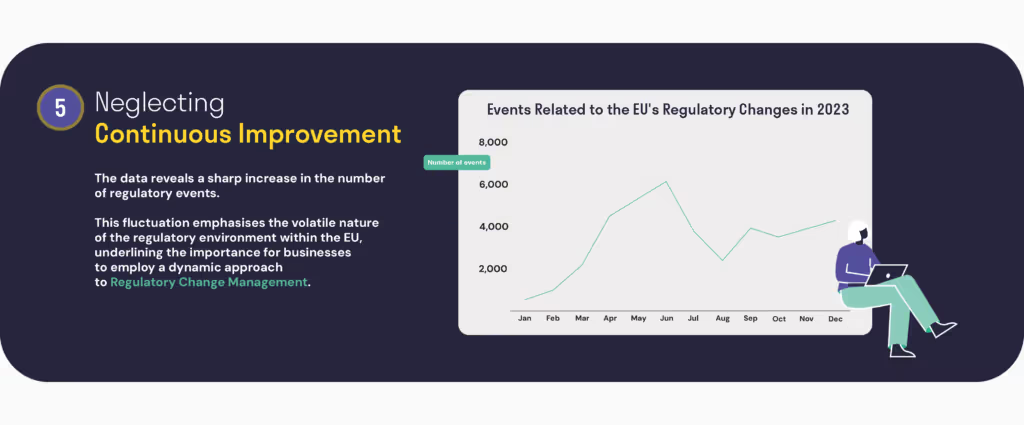In an era characterised by information ubiquity and digital interconnectedness, the stakes in managing reputational risk have never been higher. Adverse Media Monitoring, a linchpin in contemporary risk management strategies, demands a nuanced approach to navigating the intricacies of data analysis and interpretation.
Adverse Media Monitoring serves as a pivotal mechanism with the primary goal of delivering early detection of risks stemming from unforeseen events that may disrupt client value chains as well as identifying and evaluating potential financial, legal, or reputational risks stemming from associations with individuals or entities engaged in questionable or illicit activities. This strategic process is indispensable across multifaceted domains such as Supplier Risk, Credit Risk, and general Compliance, encompassing critical components like Anti-money Laundering (AML) and Know Your Client (KYC) regulations. By diligently scrutinising media channels and diverse information sources, organisations can unearth valuable insights that aid in making informed decisions. The proactive nature of Adverse Media Monitoring empowers businesses to stay ahead of potential risks, ensuring the effective mitigation of threats within their business relationships. In an era where risk management is integral to sustainable operations, Adverse Media Monitoring emerges as an indispensable tool, safeguarding organisations against unforeseen challenges and fortifying their resilience in the dynamic business landscape.
In this discourse, Semantic Visions delves into the intricacies of Adverse Media Monitoring, spotlighting five critical pitfalls that warrant meticulous consideration.
Pitfall Number 1 – Incomplete Data Sources
Reliance on incomplete data sources. Semantic Visions emphasises the need for a comprehensive approach, urging clients to diversify their data streams. Traditional news outlets alone may not suffice; instead, organisations should harness a multitude of sources, including blogs and niche publications. Through SAP’s alliance with Semantic Visions, a Czech-based DaaS Company, companies have access to critical SV datasets collected and processed from across the globe from over 220,000 globally monitored sources. By utilising this data, they can gain a holistic perspective and avoid overlooking critical information that may be pivotal in risk assessment.
Consider, for instance, the scenario where a multinational corporation relies solely on mainstream news outlets for Adverse Media Monitoring. By not embracing a diverse range of data sources, the organisation may inadvertently expose itself to reputational risks that could have been identified through a more comprehensive monitoring strategy.
Example – A prominent Spanish supermarket chain and a local salad supplier:

This principle is exemplified in the case of a leading player in the Spanish supermarket industry. The company faced a challenging situation with a crucial salad supplier. An analyst focusing on the chain and utilising Semantic Visions’ multilingual media coverage discovered that a significant Spanish trade union had criticised the supplier in question. The criticism was for trying to compel its workers to work on holidays to meet the buyer’s demands. This critical information, reported on Forbes.es, was largely absent from English-language media, and highlighted a key moment in the chain’s labour relations and operational strategy. This case underscores the importance of diverse data sources in providing unique insights into a company’s potential challenges, mitigation strategies and future direction, thereby preventing the pitfalls of incomplete data sources.
Pitfall Number 2 – Narrow Semantic Analysis
Traditional keyword-based searches may fall short in the dynamic realm of Adverse Media Monitoring. By employing advanced natural language processing and machine learning techniques, SAP and Semantic Visions empower clients to transcend the limitations of surface-level analysis and embrace semantic analysis, mimicking how the human brain reads text by extracting events, entities, topics, and themes and analysing the relationships between them. Organisations can benefit from automated natural language processing and ML techniques that ensure a comprehensive, nuanced, and detailed analysis of potential risks. This will enable companies to detect potential threats even if they are not obvious or the report does not directly relate the risk to them.
This underscores the importance of a nuanced semantic analysis by illustrating the impact of relying solely on keyword-based searches. For instance, a manufacturer using traditional keyword methods might miss subtle variations in language that could indicate potential risks in news articles. By incorporating advanced semantic analysis, companies will be able to detect potential threats even if they are not obvious or the report does not directly relate the risk to them.
Example – A car manufacturer and ‘Vehicle Technical Failures’:

Consider the detected event by Semantic Visions of “vehicle technical failures”, which a major car manufacturer reported on January 4, 2024, where over 100,000 trucks were recalled due to a risk of rolling away while parked—a significant issue with severe consequences if not addressed in a timely manner. The related article, reported by NBCphiladelphia.com, does not explicitly use the phrase “vehicle technical failures,” yet the situation it describes is precisely that. Traditional keyword-based searches would not have flagged this article if they were set to trigger only on the specific phrase. However, by using advanced natural language processing and machine learning techniques, Semantic Visions can capture this event by understanding the context and the semantic relationships present in the text.
Pitfall Number 3 – Overlooking Global Context
In the dynamic realm of global business, the ability to monitor your supply chain comprehensively, from start to finish, is crucial for staying ahead of potential risks. Semantic Visions’ collaboration with SAP underscores the significance of this end-to-end approach, going beyond merely understanding regional nuances.
By actively monitoring global news sources in 12 languages, Semantic Visions showcases how this practical, end-to-end strategy works in action. The languages include English, Spanish, Italian, Russian, German, French, Portuguese, Arabic, Japanese, Chinese, Korean, and Czech, covering many regions and markets. This practical integration empowers your business to proactively identify, assess, and respond to global, national, regional, or local risks, allowing for informed decision-making.
The chart below illustrates how Semantic Visions’ multilingual monitoring provides businesses with a competitive edge. This capability extends beyond English media sources, uncovering important global news that might otherwise be missed. This broader perspective helps companies maintain a lead by leveraging information that is not readily available to everyone.

Consider a practical scenario: Picture a company venturing into a new market. Without a robust end-to-end supply chain monitoring system, the organisation might face unforeseen challenges. For instance, if the system doesn’t account for local nuances, cultural differences, or language intricacies, the company could misinterpret critical information and make decisions that lead to disruptions.
Pitfall Number 4 – Delayed Response due to Lack of Timely Monitoring
Adverse Media Monitoring is a race against time. Through our alliance, SAP and Semantic Visions provide organisations with the capability of near real-time monitoring to identify and respond to emerging threats promptly. Delayed responses can allow negative narratives to gain traction, potentially causing irreversible damage to an organisation’s operations and, critically, its reputation. Implementing timely monitoring tools is critical in staying ahead of the curve and addressing risks proactively. These tools do not rely on humans to deliver the analysis, which by its nature can be time-consuming and inherently biased, but on fully automated systems that deliver timely and high-precision data that is analysed to manage supply chain risks.
In the realm of near real-time monitoring, imagine a situation where an organisation relies on periodic updates for Adverse Media Monitoring. In a rapidly evolving news landscape, delayed responses to emerging threats could result in severe operational delays and reputational damage.
In this context, consider the case of a leading technology company. The company faced a significant hurdle when a patent dispute arose concerning the blood oxygen measurement technology in its smartwatches. This resulted in a temporary halt of sales in the United States, as reported by BBC on December 18, 2023. Media coverage, as indicated by the charts below, began to escalate on the same day the sales suspension was announced. The situation reached its highest level of public and media attention on December 29, 2023. The stock price subsequently decreased as a consequence. This example underscores the critical need for organisations to maintain up-to-the-minute media monitoring to rapidly address and mitigate emerging threats that could lead to operational disruptions and damage to reputation.

Pitfall Number 5 – Neglecting Continuous Improvement
The fifth pitfall centers around the tendency to neglect ongoing Machine learning and AI-based refinement and enhancement of Adverse Media Monitoring strategies. It is crucial to emphasise the importance of implementing a dynamic approach that adapts to evolving risk landscapes and compliance standards. A stagnant monitoring process can become obsolete, rendering organisations vulnerable to emerging threats. A commitment to continuous improvement is essential, the point of which is to urge clients to regularly reassess and update their Adverse Media Monitoring practices to ensure sustained effectiveness and resilience against evolving challenges in the complex business ecosystem.
To illustrate, consider a scenario where a government introduces stricter data protection regulations that directly affect the collection and processing of adverse media information, such as the General Data Protection Regulation (EU and EEA), the Personal Data Protection Law (Qatar, Turkey), the Personal Data Protection Act (Saudi Arabia), and Data Protection Law (UAE). At the same time, tier 2 and tier 3 suppliers, integral supply chain components, are constantly evolving. Organisations may find themselves inadvertently non-compliant without an adaptable strategy, facing legal consequences and operational setbacks. By staying attuned to regulatory updates and promptly adjusting Adverse Media Monitoring practices, businesses can proactively navigate such changes, ensuring compliance and maintaining the resilience of their risk management framework. The commitment to ongoing refinement and enhancement extends beyond internal processes, encompassing external factors to create a comprehensive and adaptable approach to Adverse Media Monitoring.

The above chart highlights the flow of regulatory events within the European Union over the course of 2023. The data reveals a sharp increase in the number of regulatory events beginning in January and reaching a peak in June, followed by a subsequent stabilisation towards the end of the year. This fluctuation emphasises the volatile nature of the regulatory environment within the EU, underlining the importance for businesses to employ a dynamic approach to Regulatory Change Management.
In the dynamic and high-stakes realm of Adverse Media Monitoring, the SAP and Semantic Visions partnership provides strategic insights to help organisations steer clear of potential pitfalls. By addressing challenges related to data sources, semantic analysis, global context, real-time monitoring, and compliance integration, we empower clients to fortify their risk management strategies.
As a trusted partner within the SAP family, Semantic Visions ensures that organisations can navigate the complexities of Adverse Media Monitoring with precision, foresight, and confidence.
See Everything. Focus on What Matters.
svEye™ filters the noise to uncover meaningful patterns and insights. Gain clarity, stay informed, and drive smarter decisions with a comprehensive overview.







